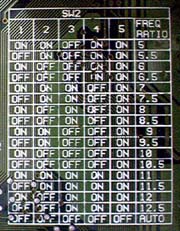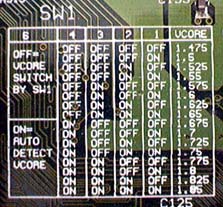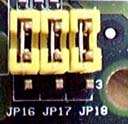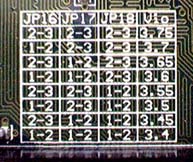EPoX EP-8KTA2 Socket-A KT133 (686B) ATX
by Henry Kuo on November 14, 2000 12:00 PM EST- Posted in
- Motherboards
Overclocking
Overclocking the CPU has become quite common among hardware enthusiasts, and current AMD processors are among the most overclockable processors available. Overclocking can be accomplished by changing either the FSB speed or the multiplier ratio, but multiplier overclocking is by far the easiest way to overclock your AMD Duron or Athlon for a few simple reasons. Most important is the fact that the KT133 chipset is currently unable to run the FSB above 110MHz while maintaining stability in the vast majority of cases. However, most AMD processors that are currently available are "multiplier locked," meaning that you cannot change the multiplier easily. We put that in quotes because "unlocking" these CPU's is as simple as reconnecting the L1 bridges on the processor. If you are interested in knowing how to unlock AMD processors and overclocking, please refer to our AMD Thunderbird & Duron Overclocking Revealed article.
The implementation of multiplier ratio settings is not within the spec of KT133 chipset, but nowadays, most people consider multiplier settings as a must have when they are considering a KT133 motherboard. EPoX does not disappoint, as they have implemented a set of dipswitches that provide a total of 16 multiplier ratio settings, from 5 to 12.5 in 0.5 steps. Therefore, the motherboard can theoretically run any AMD processors at a clock speed of 1.25GHz. Practically that's not possible because of heat issues and CPU yield, but as shown in our Microstar K7T Pro2 and Soyo SY-K7VTA (Retail) reviews, multiplier overclocking can yield much better results than FSB overclocking.
 |
 |
Beside the multiplier ratio settings, EPoX also puts in a lot of FSB speeds settings, which will help users push their CPUs to the absolute limit. The EP-8KTA2 uses Award's Modular BIOS 6.00PG, which has built-in support for a jumperless CPU setup. FSB speeds available are 95 / 100 / 102 / 104 / 106 / 107 / 108 / 109 / 110 / 111 / 112 / 113 / 114 / 116 / 118 / 120 / 124 / 127 / 130 / 133 / 136 / 140 / 145 / 150 / 155 / 160 / 166 MHz. Ideally FSB settings with 1MHz increments would allow users to squeeze the last bit of juice from the CPUs, but the settings EPoX provides should satisfy most users. Although we would prefer to have most settings between the 100MHz and 110MHz range, rather than above 110MHz, since the KT133 chipset cannot maintain stability with FSB speeds higher than 110MHz.
Beyond multiplier ratio settings and a wide range of FSB speed choices, a complete overclocking package would include options in CPU core voltage and I/O voltage. That is exactly what EPoX delivers with the EP-8KTA2. The CPU core voltages can be adjusted using a set of dipswitches, which allow you to choose voltages between 1.475V and 1.850V in 0.025V increments.
 |
 |
You can also change the I/O voltage, using a set of 3 jumpers, between 3.4V and 3.75V in 0.05V increments. Although we have yet to see evidence that I/O voltages can be helpful in overclocking, it is always a nice option to have.
 |
 |
In order to illustrate the overclocking power of the motherboard, we again perform the same overclocking test we have had for the previous boards. We used the same AMD Thunderbird 800MHz OEM CPU, with the same ordinary HSF unit, and tried to see how much overclocking we could do to the CPU before it lost stability. We first fixed the FSB speed at 100MHz, and 9.5 was again the highest multiplier settings could achieve. Then we started to raise the FSB speeds and 104MHz was the highest speed we could get. At 106MHz FSB, the next setting above 104MHz, the system couldn't even POST. Here we can see the importance of having FSB speeds in 1MHz increments between 100MHz and 110MHz. The final clock speed of the CPU was 988MHz (104MHz x 9.5). Note that we stayed with the default voltage for a fair comparison.










0 Comments
View All Comments